Reed frogs are well known for the diversity of their appearance.
Walk into a local reptile shop or attend a herp show and you’ll find many kinds of frogs for sale, but few pack as much punch into their size as do the reed frogs. Sure, asleep on the glass of a terrarium during the day they may not resemble much more than your average tree frog in miniature, but shine a flashlight into the cage at night and you will find any number of nocturnal amphibian dramas playing out for you to observe.
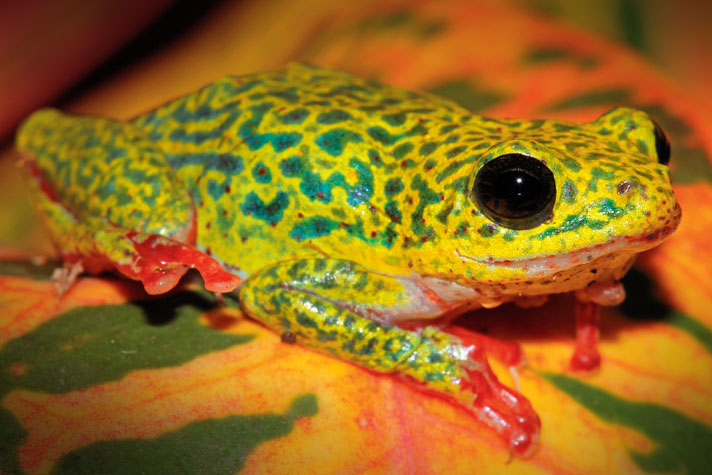
Ryan M. Bolton/Shutterstock
This common reed frog (Hyperolius viridiflavus) was photographed in Uganda.
Reed frogs are ambitious predators for their size and take impressive leaps to catch their prey. Males are territorial and vocalize loudly to defend a favorite perch from competition, using yet a different boisterous call to attract a mate. They are agile and fast, active beyond that of your average pet amphibian. The attractive coloration of the most popular species makes them a perfect choice for display in a lively planted terrarium. It’s true they are small, but with so many charismatic qualities and species to choose from it is hard to find any larger frog as appealing as the reed frogs.
Reed Frog Diversity
Also known occasionally as sedge or bush frogs, reed frogs are composed of three genera within the family Hyperoliidae: Afrixalus (banana reed frogs), Heterixalus (Madagascar reed frogs) and Hyperolius (African reed frogs). All are small amphibians, with some species maturing at less than an inch in length and few reaching more than 1.5 inches. There are a dozen or more species available through dealers, breeders and pet stores, and they all require similar care in captivity.
Hyperolius species are the most common. The genus contains a daunting 140+ species, many of which are patterned in vivid contrasting colors. They range throughout bush lands, savannah and forests in sub-Saharan Africa. Commonly misidentified by sellers, they are also sometimes sold unidentified and found listed ambiguously as “assorted reed frogs.” Some available species include the argus reed frog (H. argus), lime reed frog (H. fusciventris), painted reed frog (H. marmoratus), Mitchell’s reed frog (H. mitchelli), golden reed frog (H. puncticulatus), Riggenbach’s reed frog (H. riggenbachi), tinker reed frog (H. tuberilinguis) and the common reed frog (H. viridiflavus). Other Hyperolius species are sporadically available as well.
A few species in the genus Afrixalus are also regularly offered for sale, sometimes being called banana or spiny reed frogs. The two usually encountered are A. dorsalis and the larger A. fornasini. These frogs are not especially striking—muddy brown with a tan or cream pattern—but Afrixalus species are notable in that they are “egg folders,” meaning they lay eggs on leaves above water that they then fold over and seal together in a sort of packet. This is a unique reproductive strategy known in only a couple other types of frogs from elsewhere in the world.
The third reed frog genus Heterixalus is my favorite. It contains only 11 species that are restricted to the island of Madagascar off the southeast coast of Africa. Several are available for sale, including the starry night reed frog (H. alboguttatus) and the blue-back reed frog (H. madagascariensis). These two species display some of the most dramatic coloration and patterns of any of the commonly encountered species in the trade. If you have doubts about identifying the Madagascar Heterixalus reed frogs from their equally colorful mainland African counterparts in the genus Hyperolius, just look at the shape of the pupils; Madagascar reed frogs have vertically oriented black dots in their eyes, while Hyperolius have horizontally oriented pupils.
Keep Captive-Bred Reed Frogs
If there is a downside to keeping reed frogs, it is searching for individuals produced in captivity rather than caught in the field. Most reed frogs are still sourced from the wild, and as a result are sometimes offered for sale in poor condition. Examine individuals closely before purchase and when possible buy captive-bred specimens directly from a breeder.
Captive-bred Madagascar blue-back and starry night reed frogs are available on a somewhat regular basis, while captive-bred Hyperolius and Afrixalus from mainland Africa can be trickier or impossible to find. Herp shows and classifieds (print and online) are a good place to start searching. The average pet store or larger herp dealers may be more prone to stocking wild-caught frogs.
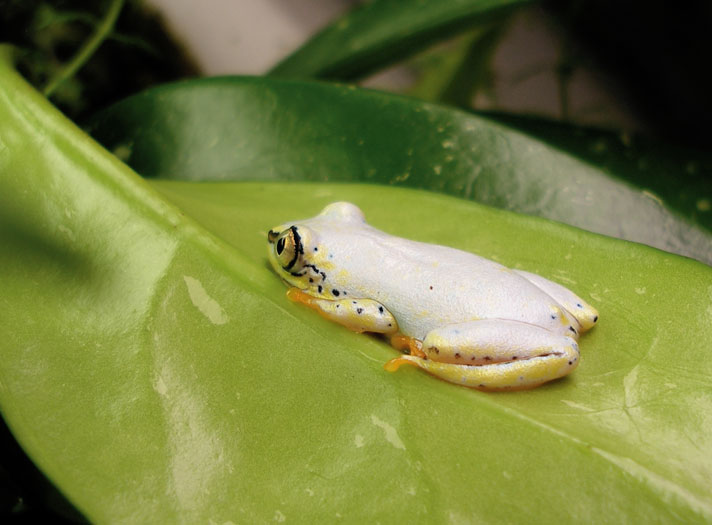
devin edmonds
Reed frogs are well known for the diversity of their appearance, even among species. This is a blue-backed reed frog (Heterixalus madagascariensis).
A healthy reed frog should have no scratches or blemishes, respond quickly and jump away when disturbed, and have a somewhat convex body shape while asleep, which is how they should be during the day unless there is food available or their enclosure has recently been misted with water.
After bringing frogs home, consider housing them for a month or so in a simple setup rather than a complex planted terrarium where they may be difficult to observe. Reed frogs are adaptable and resilient once acclimated to a new setup, but it can take some time for them to adapt to these conditions, so it is important to keep a close eye on them after purchase.
Hyperoliidae Housing
They’re small but lively, so reed frogs should be provided with ample space relative to their body size. A standard 20-gallon aquarium with a screen cover is spacious enough for five to 10 adult frogs (a good-sized group to maintain because if you keep only one or two reed frogs, you may not get to observe their full range of behavior). Vertically oriented glass enclosures with access through the front are even better housing options than regular top-opening aquariums because reed frogs are prone to unexpectedly run upward on the glass or leap toward an open top when disturbed.
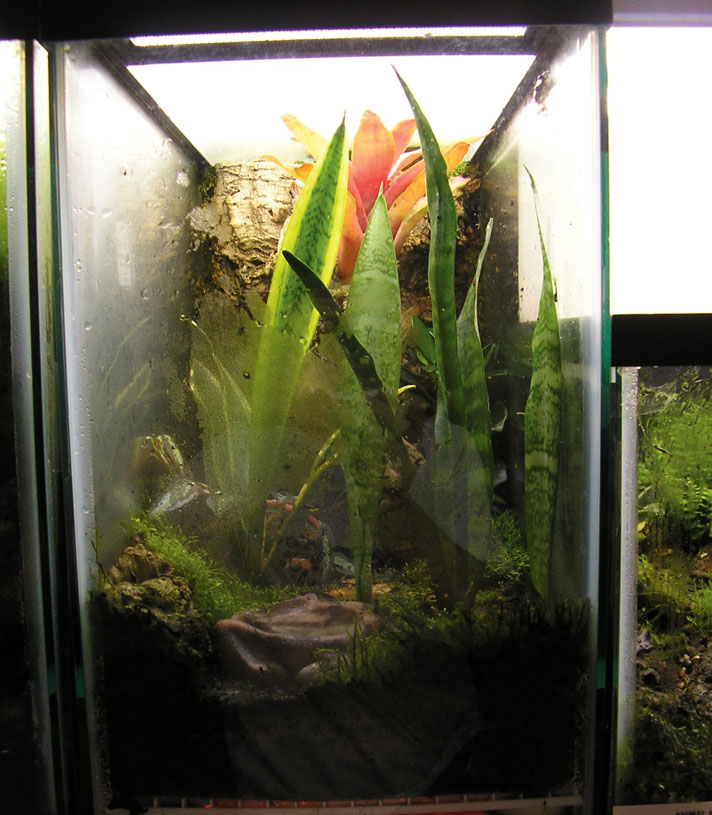
devin edmonds
Besides a water area and plants, perches made from driftwood, cork bark or bamboo can also be added for aesthetics and extra footing above ground.
In the wild, reed frogs spend their days asleep on vegetation so plants should be a key component of their housing. These can be artificial if you want to keep it simple, though live plants–either grown in pots or planted directly in a substrate of moss or soil—add an engaging element to the enclosure that is hard to duplicate with their plastic equivalent. Good plant choices for reed frogs include mother’s tongue (Sansevieria trifasciata), small bird’s nest ferns (Asplenium nidus), various large-leafed Philodendron species and the ever-popular pothos (Epipremnum aureum). Remember to wash live plants thoroughly with water and grow them outside of the terrarium for several weeks prior to use to ensure residual pesticides, fertilizers, leaf shiners or other potentially harmful chemicals have a chance to dissipate before using with your frogs.
The substrate you choose is not especially important because reed frogs rarely spend time on the ground, but it should be easy to maintain so that it isn’t prone to neglect. Moist paper towels are about as simple as it gets, but need to be replaced several times each week and don’t create a particularly attractive environment. River stones or large-grade gravel are also appropriate, but they don’t hold moisture and can be a bit laborious to keep clean. Some keepers keep reed frogs on soil mixtures, usually based around coconut husk fiber, in which live plants can be grown.
Fiberglass window screening cut to the footprint of the terrarium and placed over an inch or two of river stones or large gravel and covered with a layer of wetted sphagnum moss is my preferred substrate for reed frogs. The screening and bottom layer of gravel prevents the sphagnum moss on top from becoming waterlogged, and as long as the terrarium has a fresh smell to it, the moss may only need to be replaced once every few months.
On top of or nestled within the substrate should be a large water dish an inch or two deep. Although reed frogs mainly dwell above ground, they have webbed feet and are good swimmers, often diving into water when disturbed. A water area can also be created by building a gravel slope that extends up to a moss or soil substrate at one end of the enclosure; fill the other end with enough water so that it gathers in a pool, but not so much that it reaches the moss/soil substrate.
Water from the tap that is treated with an aquarium additive to remove chlorine and chloramines a day in advance usually works fine with reed frogs. Alternatively, if you have doubts about the tap water in your area, reverse osmosis (RO) water can be reconstituted with minerals using aquarium products so that it is safe for amphibians.
Besides a water area and plants, perches made from driftwood, cork bark or bamboo can also be added for aesthetics and extra footing above ground, even though you may find the frogs spend as much time asleep on the glass during the day as they do on cage items such as these.
Daily maintenance for reed frogs involves misting the terrarium, changing the water if using a dish, monitoring environmental conditions and spot cleaning.
Reed Frog Lighting Requirements
Few frogs benefit the way reed frogs do from a well-lit enclosure. Proper lighting affects their health, coloration and activity, and it is an important aspect of their captive husbandry that shouldn’t be overlooked.
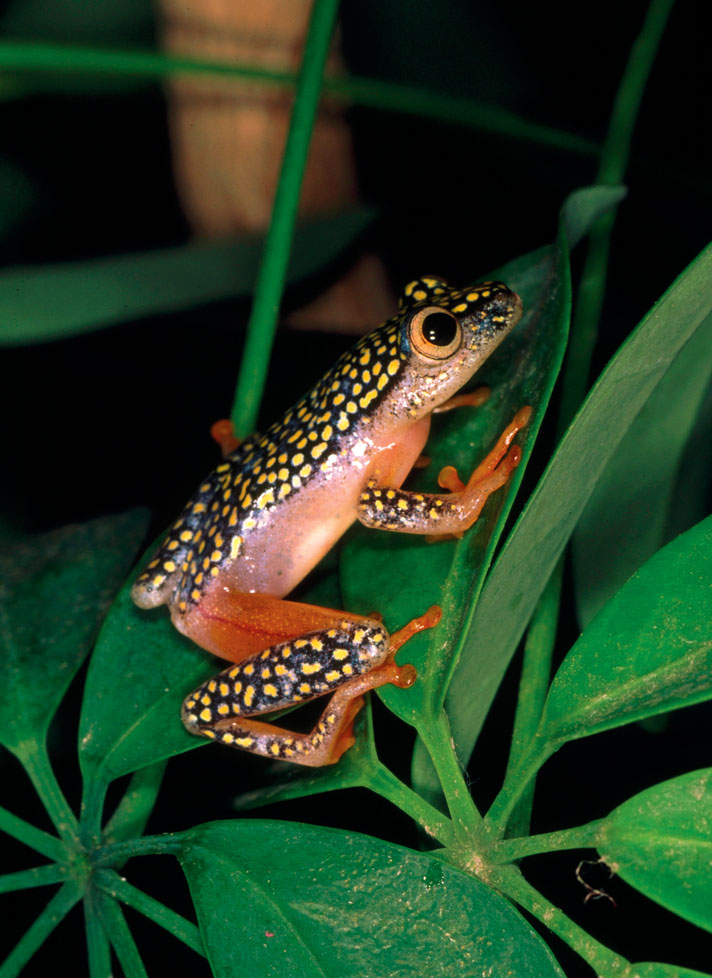
paul freed
Heterixalus is the author’s favorite reed frog genus. The starry night reed frog (H. alboguttatus) is especially eye-catching.
The first consideration when choosing a light source is temperature. The ambient air temperature in the terrarium during the day should stay in the range of 70 to 78 degrees Fahrenheit. Also provide a small heat lamp toward the top at one end of the enclosure to create a warmer area of 85 to 90 degrees. Often reed frogs can be found sleeping in this warm spot near the light during the day, showing off particularly vivid coloration. At night, all lights should be turned off and the air temperature can drop by 10 degrees. Use a thermometer to monitor the temperature in various parts of the enclosure—guessing isn’t good enough.
The second consideration when choosing a light is the type of light it produces. Although a standard incandescent light bulb may provide warmth, it does not illuminate a terrarium well, so in addition to producing heat, the light source should also be bright, with the color temperature of the bulb ideally 5,000 to 6,000 Kelvin. This bright white light will encourage reed frogs to show their best coloration.
Although UVB lighting is usually associated with reptile care, there is increasing evidence that this type of non-visible light is also important for amphibians. This is probably especially true for types of frogs that are regularly exposed to sunlight in nature. Because reed frogs often sleep on vegetation in rather open areas in the wild, it is not a bad idea to provide a light source that also produces low levels of UVB radiation.
All these different aspects of lighting may seem overwhelming, but don’t worry, the top of the terrarium does not need to be filled with lots of different fixtures and costly light bulbs. Instead, it is usually possible to meet all requirements with a couple UVB-emitting spiral compact fluorescent bulbs, or a combination of a UVB fluorescent strip light and a low-wattage incandescent heat lamp. So long as the temperature is appropriate, the light is bright, and there is access to low levels of UVB radiation, reed frogs will live and display well in captivity.
Reed Frogs are Petite Predators
Reed frogs are surprisingly aggressive predators for their size. Though able to subsist on the usual fair of quarter-inch-long crickets and flightless fruit flies, varying their diet a few times per month by offering flying insects is not only beneficial for the frogs but also fun for the keeper.
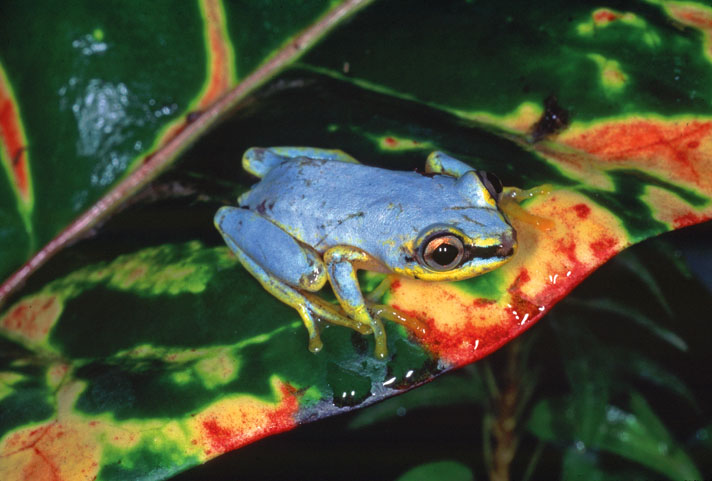
devin edmonds
A favorite food of reed frogs is houseflies, which can be ordered from insect suppliers while still in their larval stage.
A favorite food of reed frogs is houseflies, which can be ordered from insect suppliers while still in their larval stage (sometimes sold as “spikes”), allowed to pupate into flying adults in a small, ventilated container, and then refrigerated and kept alive for up to one month. The cold immobile flies can then be dumped into the reed frog terrarium, where they will awaken from their dormancy and begin flying around, giving the frogs an arboreal snack to chase. Wax worms can also be allowed to pupate to their flying adult moth stage and used in this way.
Feed reed frogs two to four times each week in quantities that allow all food items to be eaten overnight. If there are insects walking or flying around the enclosure the next morning you have offered too many; conversely, if everything is eaten in a matter of minutes, you’re not offering enough.
Dust crickets and fruit flies with a powdered nutritional supplement before offering them to the frogs. The supplement should contain calcium, vitamin D3, and be phosphorus free. It should also contain vitamin A rather than beta-carotene, the latter which amphibians may not be able to utilize. Keep an eye on the age of nutritional supplements, too, because they typically expire three to six months after being opened.
Reed Frog Reproduction
Observing the entire life cycle of reed frogs is not something most keepers have the chance to do, which is unfortunate because if more people bred them in captivity it would help supply better-quality frogs to the pet trade. And with the right conditions and a large group of frogs, it is not usually too difficult to coax reed frogs to reproduce.
The first step is ensuring you have a group with both males and females. Although some people have on occasion had success breeding reed frogs with just a few individuals, in my experience, frogs seem more inclined to reproduce in captivity when kept in larger groups. At least three or four females and the same number or more of males would be a good place to start.
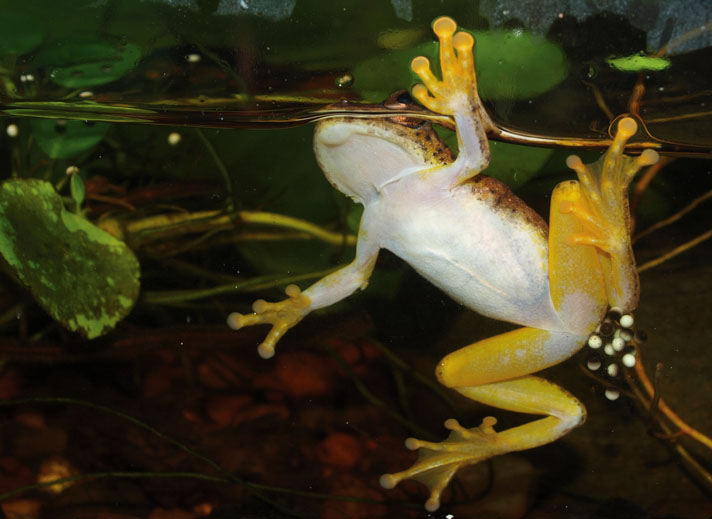
devin edmonds
This blue-back reed frog is in the process of depositing eggs.
Sexing reed frogs is not usually difficult. Males vocalize, and often their vocal sac will be colored after a night of calling. Males are also smaller and more streamlined in shape than females, though this may depend on species and vary with individuals. Eggs can also readily be seen through the skin of gravid females, so if there are clusters of spherical shapes visible in the abdomen, then the frog is female.
A number of Hyperolius species are also sexually dimorphic in coloration, making it especially simple to tell them apart. In some species, males retain juvenile coloration and adult females display a whole new range of colors; in other species, juveniles, adult males and adult females are all patterned or colored differently than one another. Available Hyperolius species that have sexually dimorphic coloration include the argus, lime, Riggenbach’s, tinker and common reed frogs, as well as Parker’s reed frog (H. parkeri).
Once you have a group with both males and females, the next step is getting them into prime breeding condition. Feed regularly, as often as daily, and with a variety of foods until females are visibly gravid. Males that are ready to breed will call loudly at night, and sometimes even during the day after the terrarium is misted, which should be done at least once per day and night. Restricting ventilation to increase humidity to 80 to 100 percent can also help ready reed frogs to reproduce.
Make an African Reed Frog Breeding Pond
When females appear swollen with eggs and males are calling, there is not much else to do other than make sure there is a place for frogs to lay eggs. Reed frogs may do this in a big water dish, but more often a larger area of water containing aquatic vegetation is required. Moving frogs to a new enclosure with 2 to 5 inches of water in the bottom is one option. Cork bark and driftwood should be positioned to float on or protrude from the water’s surface. Plants such as parrot feather (Myriophyllum aquaticum), hornwort (Ceratophyllum demersum), Java moss (Vesicularia dubyan) and Amazon frogbit (Limnobium laevigatum) can be grown aquatically, while long clippings of pothos work well draped throughout water and over driftwood perches. Alternatively, a breeding setup may be created simply by flooding the existing enclosure with several inches of water; remove soil or moss substrates that spoil when submerged beforehand.
Water quality is of extreme importance in a semi-aquatic breeding setup for reed frogs. Take care to remove dead feeder insects and feces from the water, and change at least half of the water weekly. These water changes may also help stimulate breeding. If no breeding is observed after a few weeks, return the frogs to their normal type of housing and wait a month before attempting to induce breeding again.
Egg, Tadpole and Froglet Care for the African Reed Frog
Eggs can number from a few dozen into the hundreds and will be found in water draped around aquatic vegetation or, depending on species, adhered above water on the sides of the terrarium or leaves. Tadpoles hatch from eggs after a week or so and grow to about 1.5 inches in length before their rear legs emerge; front arms should appear at 1.5 to 4 months of age. Tadpoles are not picky eaters and will grow well on most aquarium flake or pellet fish foods, as long as the water temperature is maintained at about 70 to 75 degrees. A submersible aquarium heater can be used, if needed.
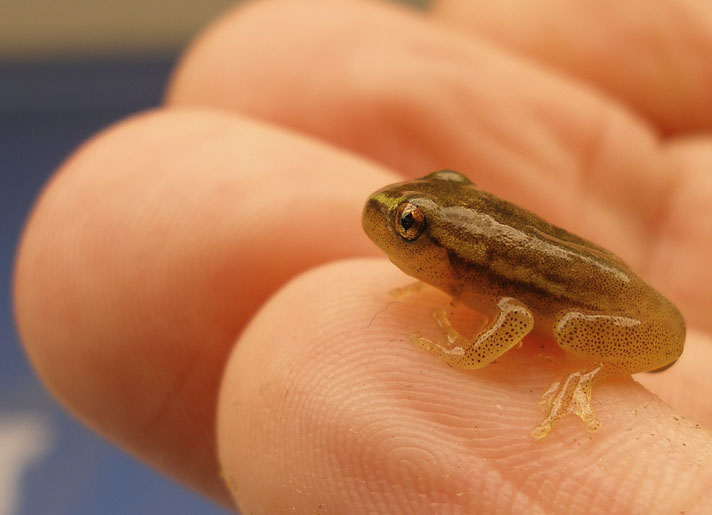
devin edmonds
This juvenile blue-back reed frog has just emerged from the water.
Once larvae develop front arms they will climb out of the water onto the sides of the aquarium. From there, they can be picked off and placed into a separate enclosure (ventilated deli cups or similar small containers work well) with less than half an inch of water and a few plant leaves to rest upon.
After a few days, when the tail is fully absorbed, the tiny frogs require lots of tiny, live food. Fruit flies and week-old crickets can form the bulk of their diet, and should be coated with a nutritional supplement at every feeding. Feed juvenile reed frogs daily and watch carefully for small individuals that may be outcompeted for food by larger frogs. Smaller ones should be sorted into separate enclosures or individual plastic containers until they put on some size. Adult coloration develops during the first few months, and by the first year of age, reed frogs reach sexual maturity.
Want To Learn More?
As appealing as reed frogs are to keep and breed, they may not be for everyone. They are fast and jumpy and may be difficult to contain for people who are not accustomed to keeping small frogs. Finding individuals for sale in good condition can be a little tricky, too, and people sometimes struggle at the start when first acclimating reed frogs to new conditions. Also, this article would not be complete without mentioning that the call of some reed frog species can be piercingly loud, so it is not recommended that they be kept near any bedrooms!
However, if you already have a little experience keeping frogs in captivity and are looking for some color and action to display in a terrarium, then definitely consider the reed frogs. They may be small, but what they lack in size they make up for in more ways than one.
Devin Edmonds has kept amphibians since childhood and has authored three books about their care in captivity. He is the Amphibian Conservation Director of Association Mitsinjo in Andasibe, Madagascar, where he manages a breeding facility for threatened frog species.


